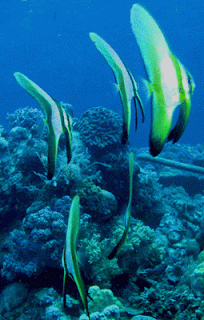Bunaken Marine Park
Only a few kilometers offshore from
Manado city lies Bunaken marine park, This tiny cluster of islands is
surrounded by some of Indonesia's very finest coral reefs, acclaimed by divers
the world over and frequently visited by the world's top underwater photographers,
who find the perfect combination of abundant marine life, pristine coral and
calm, crystal-clear water unbeatable.
The Bunaken marine park is
a true natural wonder, each island ringed by a dense coral reef which almost
makes the naming of individual site pointless-the whole place is one huge dive
site. Diving in this area is almost without exception wall diving-on sheer,
vertical coral walls with phenomenal growth well into the depth, often well
below 50m (165ft). Fish life is both profuse and diverse, with strong showing
from all the common reef fishes and frequent visitations from deeper-water
species like sharks, rays, tuna and jacks.
There are abundant turtles
on the reefs, and a diversity of nocturnal species which is absolutely
remarkable. Diving condition are exceptional, which visibility consistently in
the 25-30m (82-100ft) range, sometimes 40m (130ft) or more, and water
temperatures generally around 26-27 C (78-80 C).
Bunaken National Park is
very representative of Indonesian tropical water ecosystems, consisting of
seagrass plain, coral reef, and land/coastal ecosystems. The northern part of
the Park area covers the islands of Bunaken, Manado Tua, Montehage, Siladen,
Nain and Nain Kecil, and part of the Tanjung Pisok coastal area. The southern
part of the Park covers part of the Tanjung Kelapa coast. On land, these
islands are rich in species of palm, sagu, woka, silar and coconut. Among the
animal species that live on the land and the beaches are black-crested macaques
(Macaca nigra nigra), Timor deer (Cervus timorensis russa), and bear-cuscus
(Ailurops ursinus ursinus).
The mangrove forest of the
Park contains, among others, Rhizophora sp., Sonneratia sp., Lumnitzera sp.,
and Bruguiera sp. This forest is also rich in species of crab, lobster,
mollusc, and sea birds such as gulls, herons, sea doves, and storks. The
seaweed species that can be found here include Caulerpa sp., Halimeda spp., and
Padina spp., while the dominant seagrasses, in particular in the islands of
Montehage and Nain, are Thalassia hemprichii, Enhallus acoroides, and
Thalassodendron ciliatum.
Thirteen
species of coral have been recorded in the waters of the Park, dominated by
fringing reef coral and barrier reef coral. An interesting feature is the 25-50
metre vertical coral wall which is inhabited by 13 coral genus. About 91
species of fish live in the waters of the Park, among them being the emperor
angelfish (Pomacanthus imperator), almaco jack (Seriola rivoliana), spotted
seahorse (Hippocampus kuda), yellowstripe snapper (Lutjanus kasmira), four
saddle rock cod (Ephinephelus spilotoceps), pinkish basslet (Pseudanthias
hypselosoma), two-lined monocle bream (Scolopsis bilineatus), etc.; and species
of mollusc such as the great clam (Tridacna gigas), horned helmet (Cassis
cornuta), pearly-chambered nautili (Nautilus pompillius), and ascidians. There
are five islands in the Park (Bunaken, Manado tua, Siladen, Montehage and Nain
island) where visitors can enjoy diving, snorkelling and marine tours
=====o0o=====
















